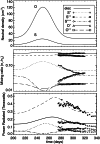Mass Supply from Io to Jupiter's Magnetosphere
- PMID: 39925795
- PMCID: PMC11799133
- DOI: 10.1007/s11214-025-01137-x
Mass Supply from Io to Jupiter's Magnetosphere
Abstract
Since the Voyager mission flybys in 1979, we have known the moon Io to be both volcanically active and the main source of plasma in the vast magnetosphere of Jupiter. Material lost from Io forms neutral clouds, the Io plasma torus and ultimately the extended plasma sheet. This material is supplied from Io's upper atmosphere and atmospheric loss is likely driven by plasma-interaction effects with possible contributions from thermal escape and photochemistry-driven escape. Direct volcanic escape is negligible. The supply of material to maintain the plasma torus has been estimated from various methods at roughly one ton per second. Most of the time the magnetospheric plasma environment of Io is stable on timescales from days to months. Similarly, Io's atmosphere was found to have a stable average density on the dayside, although it exhibits lateral (longitudinal and latitudinal) and temporal (both diurnal and seasonal) variations. There is a potential positive feedback in the Io torus supply: collisions of torus plasma with atmospheric neutrals are probably a significant loss process, which increases with torus density. The stability of the torus environment may be maintained by limiting mechanisms of either torus supply from Io or the loss from the torus by centrifugal interchange in the middle magnetosphere. Various observations suggest that occasionally (roughly 1 to 2 detections per decade) the plasma torus undergoes major transient changes over a period of several weeks, apparently overcoming possible stabilizing mechanisms. Such events (as well as more frequent minor changes) are commonly explained by some kind of change in volcanic activity that triggers a chain of reactions which modify the plasma torus state via a net change in supply of new mass. However, it remains unknown what kind of volcanic event (if any) can trigger events in torus and magnetosphere, whether Io's atmosphere undergoes a general change before or during such events, and what processes could enable such a change in the otherwise stable torus. Alternative explanations, which are not invoking volcanic activity, have not been put forward. We review the current knowledge on Io's volcanic activity, atmosphere, and the magnetospheric neutral and plasma environment and their roles in mass transfer from Io to the plasma torus and magnetosphere. We provide an overview of the recorded events of transient changes in the torus, address several contradictions and inconsistencies, and point out gaps in our current understanding. Lastly, we provide a list of relevant terms and their definitions.
© The Author(s) 2025.
Conflict of interest statement
Competing InterestsThe authors have no relevant financial or non-financial interests to disclose.
Figures






















References
-
- Ackley PC, Hoey WA, Trafton LM, Goldstein DB, Varghese PL (2021) Hybrid dust-tracking method for modeling Io’s Tvashtar volcanic plume. Icarus 359:114274. 10.1016/j.icarus.2020.114274
-
- Austin JV, Goldstein DB (2000) Rarefied gas model of Io’s sublimation-driven atmosphere. Icarus 148(2):370–383. 10.1006/icar.2000.6466
-
- Badman SV, Bonfond B, Fujimoto M, Gray RL, Kasaba Y, Kasahara S, et al. (2016) Weakening of Jupiter’s main auroral emission during January 2014. Geophys Res Lett 43(3):988–997. 10.1002/2015GL067366
-
- Bagenal F (1994) Empirical model of the Io plasma torus: Voyager measurements. J Geophys Res Space Phys 99(A6):11043–11062. 10.1029/93JA02908
-
- Bagenal F (1997) The ionization source near Io from Galileo wake data. Geophys Res Lett 24(17):2111–2114. 10.1029/97GL02052
Publication types
LinkOut - more resources
Full Text Sources
